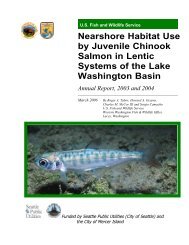2005 State of Mobility Report - City of Bellevue
2005 State of Mobility Report - City of Bellevue
2005 State of Mobility Report - City of Bellevue
You also want an ePaper? Increase the reach of your titles
YUMPU automatically turns print PDFs into web optimized ePapers that Google loves.
Ridesharing<br />
Travel by more than one person in privately- or<br />
publicly-owned vehicles, including carpools and<br />
vanpools. (Chapter 12)<br />
Roadway Classification<br />
A system <strong>of</strong> categorizing roadways by their primary<br />
functional use. A Principal Arterial connects<br />
freeway interchanges to major concentrations <strong>of</strong><br />
commercial activity and provides connections<br />
between large community centers and facilities.<br />
A Minor Arterial connects principal arterials to<br />
residential and commercial activities and provides<br />
connections between large community centers<br />
and facilities. Collectors connect two or more<br />
neighborhoods or industrial areas and distributes<br />
traffic within them. A Local Street provides access<br />
to abutting land uses and serves to carry local<br />
traffic to the collector/arterial system. Other Streets<br />
include cul-de-sacs and dead-end residential streets.<br />
(Chapter 8)<br />
Single-Occupant Vehicle (SOV)<br />
A vehicle containing one person. (Chapter 12)<br />
Sound Transit<br />
The Central Puget Sound Regional Transit<br />
Authority is doing business as “Sound Transit.”<br />
Sound Transit is responsible for developing and<br />
operating high capacity express bus and rail<br />
services in King, Pierce, and Snohomish Counties.<br />
(Chapters 2 and 9)<br />
Speed Cushions<br />
A Phase II physical measure used by the<br />
Neighborhood Traffic Calming Program that raises<br />
the roadway at designated points, much like a speed<br />
hump. However, speed cushions contain breaks to<br />
allow emergency vehicles to easily pass through.<br />
(Chapter 6)<br />
Spot Improvement Program<br />
A program that implements projects at locations<br />
that have a high accident potential or frequent<br />
“near-hits.” (Chapter 7)<br />
Stationary Radar Sign<br />
A sign with radar unit which detects the speed <strong>of</strong><br />
passing vehicles and displays the speed on a reader<br />
board. Implemented as a means to reduce traffic<br />
speeds on residential streets, a recent study indicates<br />
it is highly effective. (Chapter 6)<br />
System Intersection<br />
A signalized arterial intersection that serves a<br />
critical function in the flow <strong>of</strong> traffic along the<br />
city’s roadway network. (Chapters 3 and 7)<br />
Transit Service Hours<br />
A measure <strong>of</strong> the number <strong>of</strong> hours that busses serve<br />
city residents. (Chapter 9)<br />
Transportation Demand Management (TDM)<br />
Strategies to encourage people to use alternative<br />
modes – transit, ridesharing, walking, or bicycling<br />
– instead <strong>of</strong> driving alone. (Chapter 12)<br />
Transportation Facilities Plan (TFP)<br />
The <strong>City</strong>’s twelve-year transportation planning<br />
document that serves as a bridge between the 20+<br />
years long-range planning studies and the seven-year<br />
Capital Investment Program Plan. (Chapter 4)<br />
Transportation Partnership Act<br />
<strong>State</strong> legislative action that raises the gas tax<br />
incrementally by 9.5 cents. Revenue will fund<br />
transportation projects on regional corridors.<br />
Transportation System<br />
All <strong>of</strong> the transportation services and facilities<br />
designed to work together to efficiently and<br />
conveniently move people into, out <strong>of</strong>, and through<br />
the city.<br />
Volume-to-Capacity Ratio<br />
A measure to evaluate Level <strong>of</strong> Service at a system<br />
intersection that compares the average volume <strong>of</strong><br />
traffic versus the average roadway capacity at each<br />
key intersection. (Chapter 3)<br />
122<br />
<strong>2005</strong> <strong>State</strong> <strong>of</strong> <strong>Mobility</strong> <strong>Report</strong>

















